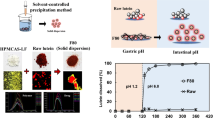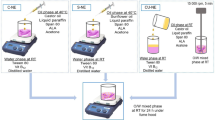Abstract
Lutein is widely used as diet supplement for prevention of age-related macular degeneration. However, the application and efficacy of lutein in food and nutritional products has been hampered due to its poor solubility and low oral bioavailability. This study aimed to develop and evaluate the formulation of oral fast-dissolving film (OFDF) containing lutein nanocrystals for enhanced bioavailability and compliance. Lutein nanocrystals were prepared by anti-solvent precipitation method and then encapsulated into the films by solvent casting method. The formulation of OFDF was optimized by Box-Behnken Design (BBD) as follows: HPMC 2.05% (w/v), PEG 400 1.03% (w/v), Cremophor EL 0.43% (w/v). The obtained films exhibited uniform thickness of 35.64 ± 1.64 μm and drug content of 0.230 ± 0.003 mg/cm2 and disintegrated rapidly in 29 ± 8 s. The nanocrystal-loaded films with reconstituted particle size of 377.9 nm showed better folding endurance and faster release rate in vitro than the conventional OFDFs with raw lutein. The microscope images, thermograms, and diffractograms indicated that lutein nanocrystals were highly dispersed into the films. After administrated to SD rats, t max was decreased from 3 h for oral solution formulation to less than 0.8 h for OFDF formulations, and C max increased from 150 ng/mL for solution to 350 ng/mL for conventional OFDF or 830 ng/mL for nanocrystal OFDF. The AUC 0-24h of conventional or nanocrystal OFDF was 1.37 or 2.08-fold higher than that of the oral solution, respectively. These results suggested that drug nanocrystal-loaded OFDF can be applied as a promising approach for enhanced bioavailability of poor soluble drugs like lutein.






Similar content being viewed by others
References
Apte RS. Targeting tissue lipids in age-related macular degeneration. EBioMedicine. 2016;5:26–7. doi:10.1016/j.ebiom.2016.02.003.
Querques G, Merle BM, Pumariega NM, Benlian P, Delcourt C, Zourdani A, et al. Dynamic Drusen remodelling in participants of the nutritional AMD treatment-2 (NAT-2) randomized trial. PLoS One. 2016;11(2):e0149219. doi:10.1371/journal.pone.0149219.
Schmidl D, Garhofer G, Schmetterer L. Nutritional supplements in age-related macular degeneration. Acta Ophthalmol. 2015;93(2):105–21. doi:10.1111/aos.12650.
Gleize B, Tourniaire F, Depezay L, Bott R, Nowicki M, Albino L, et al. Effect of type of TAG fatty acids on lutein and zeaxanthin bioavailability. Br J Nutr. 2013;110(01):1–10. doi:10.1017/S0007114512004813.
Álvarez MV, Hincapié S, Saavedra N, Alzate LM, Muñoz AM, Cartagena CJ, et al. Exploring feasible sources for lutein production: food by-products and supercritical fluid extraction, a reasonable combination. Phytochem Rev. 2015;14(6):891–7. doi:10.1007/s11101-015-9434-0.
Tian Y, Kijlstra A, Webers CA, Berendschot TT. Lutein and factor D: two intriguing players in the field of age-related macular degeneration. Arch Biochem Biophys. 2015;572:49–53. doi:10.1016/j.abb.2015.01.019.
Davidov-Pardo G, Gumus CE, McClements DJ. Lutein-enriched emulsion-based delivery systems: influence of pH and temperature on physical and chemical stability. Food Chem. 2016;196:821–7. doi:10.1016/j.foodchem.2015.10.018.
Yoo J, Baskaran R, Yoo B-K. Self-nanoemulsifying drug delivery system of lutein: physicochemical properties and effect on bioavailability of warfarin. Biomol Ther. 2013;21(2):173–9. doi:10.4062/biomolther.2013.011.
Read AM. Influence of digestion model, product type, and enrichment level on in vitro bioavailability of lutein from high lutein functional bakery products. University of Guelph. 2011.
Stancanelli R, Lojkner LD, Larsen KL, Guardo M, Cannava C, Tommasini S, et al. Structural and spectroscopic features of lutein/butanoyl-beta-cyclodextrin nanoassemblies. J Pharm Biomed Anal. 2012;71:214–8. doi:10.1016/j.jpba.2012.07.034.
Khan S, Boateng JS, Mitchell J, Trivedi V. Formulation, characterisation and stabilisation of buccal films for paediatric drug delivery of omeprazole. AAPS PharmSciTech. 2015;16(4):800–10. doi:10.1208/s12249-014-0268-7.
Shen BD, Shen CY, Yuan XD, Bai JX, Lv QY, Xu H, et al. Development and characterization of an orodispersible film containing drug nanoparticles. Eur J Pharm Biopharm. 2013;85(3):1348–56. doi:10.1016/j.ejpb.2013.09.019.
Montenegro-Nicolini M, Morales JO. Overview and future potential of buccal mucoadhesive films as drug delivery systems for biologics. AAPS PharmSciTech. 2016; doi:10.1208/s12249-016-0525-z.
Abdelbary A, Bendas ER, Ramadan AA, Mostafa DA. Pharmaceutical and pharmacokinetic evaluation of a novel fast dissolving film formulation of flupentixol dihydrochloride. AAPS PharmSciTech. 2014;15(6):1603–10. doi:10.1208/s12249-014-0186-8.
Preis M. Orally disintegrating films and mini-tablets-innovative dosage forms of choice for pediatric use. AAPS PharmSciTech. 2015;16(2):234–41. doi:10.1208/s12249-015-0313-1.
Ye X, Patil H, Feng X, Tiwari RV, Lu J, Gryczke A, et al. Conjugation of hot-melt extrusion with high-pressure homogenization: a novel method of continuously preparing Nanocrystal solid dispersions. AAPS PharmSciTech. 2016;17(1):78–88. doi:10.1208/s12249-015-0389-7.
Shen CY, Shen BD, Xu H, Bai JX, Dai L, Lv QY, et al. Formulation and optimization of a novel oral fast dissolving film containing drug nanoparticles by box-Behnken design-response surface methodology. Drug Dev Ind Pharm. 2014;40(5):649–56. doi:10.3109/03639045.2014.884116.
Kapoor R, Pathak S, Najmi AK, Aeri V, Panda BP. Processing of soy functional food using high pressure homogenization for improved nutritional and therapeutic benefits. Innov Food Sci Emerg. 2014;26:490–7. doi:10.1016/j.ifset.2014.05.015.
Aslam M, Aqil M, Ahad A, Najmi AK, Sultana Y, Ali A. Application of Box–Behnken design for preparation of glibenclamide loaded lipid based nanoparticles: optimization, in vitro skin permeation, drug release and in vivo pharmacokinetic study. J Mol Liq. 2016;219:897–908. doi:10.1016/j.molliq.2016.03.069.
Lei YY, Kong YD, Sui H, Feng J, Zhu RY, Wang WP. Enhanced oral bioavailability of glycyrrhetinic acid via nanocrystal formulation. Drug Deliv Transl Res. 2016;6(5):519–25. doi:10.1007/s13346-016-0300-4.
Lai F, Franceschini I, Corrias F, Sala MC, Cilurzo F, Sinico C, et al. Maltodextrin fast dissolving films for quercetin nanocrystal delivery. A feasibility study. Carbohydr Polym. 2015;121:217–23. doi:10.1016/j.carbpol.2014.11.070.
Alshetaili AS, Almutairy BK, Alshahrani SM, Ashour EA, Tiwari RV, Alshehri SM, et al. Optimization of hot melt extrusion parameters for sphericity and hardness of polymeric face-cut pellets. Drug Dev Ind Pharm. 2016;42(11):1833–41. doi:10.1080/03639045.2016.1178769.
Garsuch V, Breitkreutz J. Comparative investigations on different polymers for the preparation of fast-dissolving oral films. J Pharm Pharmacol. 2010;62(4):539–45. doi:10.1211/jpp/62.04.0018.
Sushma M, Raju YP, Sundaresan CR, Vandana KR, Kumar NV, Chowdary VH. Transmucosal delivery of metformin—a comprehensive study. Curr Drug Deliv. 2014;11(2):172–8.
Liew KB, Tan YT, Peh KK. Characterization of oral disintegrating film containing donepezil for Alzheimer disease. AAPS PharmSciTech. 2012;13(1):134–42. doi:10.1208/s12249-011-9729-4.
Xia YR, Chen F, Zhang HP, Luo CL. A new method for evaluating the dissolution of orodispersible films. Pharm Dev Technol. 2015;20(3):375–9. doi:10.3109/10837450.2014.882936.
Yanagi M, Hisajima T, Ishibashi H, Amemiya A, Abe S, Watanabe M. Oral candidiasis deteriorated by local application of a glucocorticoid-containing film in a mouse model. Biol Pharm Bull. 2008;31(2):278–83.
Croy SR, Kwon GS. Polysorbate 80 and Cremophor EL micelles deaggregate and solubilize nystatin at the core-corona interface. J Pharm Sci. 2005;94(11):2345–54. doi:10.1002/jps.20301.
Shanmugam S, Baskaran R, Balakrishnan P, Thapa P, Yong CS, Yoo BK. Solid self-nanoemulsifying drug delivery system (S-SNEDDS) containing phosphatidylcholine for enhanced bioavailability of highly lipophilic bioactive carotenoid lutein. Eur J Pharm Biopharm. 2011;79(2):250–7. doi:10.1016/j.ejpb.2011.04.012.
Pandey GS, Kumar R, Sharma R, Singh Y, Teotia UVS. Effects of Maltodextrin and glycerin on mechanical properties of oral fast dissolving film of salbutamol sulphate. IJAPBC. 2014;3(1):199–209.
ACKNOWLEDGEMENTS
This work was financially supported from the National Natural Science Foundation of China (81660665).
Author information
Authors and Affiliations
Corresponding author
Ethics declarations
Ethics Statement
All procedures were approved by the Animal Research Ethics Committee, General Hospital of Ningxia Medical University.
Conflict of Interest
The authors declare that they have no conflicts of interest.
Additional information
Chen Liu and Daoxiao Chang contributed equally to this article as the co-first author.
Rights and permissions
About this article
Cite this article
Liu, C., Chang, D., Zhang, X. et al. Oral fast-dissolving films containing lutein nanocrystals for improved bioavailability: formulation development, in vitro and in vivo evaluation. AAPS PharmSciTech 18, 2957–2964 (2017). https://doi.org/10.1208/s12249-017-0777-2
Received:
Accepted:
Published:
Issue Date:
DOI: https://doi.org/10.1208/s12249-017-0777-2




